Diabetes is a condition caused by an excessively high level of glucose (sugar) in the blood.
There are three main types of Diabetes: Type 1, Type 2 and Gestational.
Type 1 Diabetes develops when the body is unable to produce insulin. People with Type 1 diabetes must administer insulin directly through daily injections or an insulin pump.
Type 2 Diabetes develops when the body does not use insulin properly. Type 2 diabetes is the most common form of diabetes, accounting for 90-95% of all diagnosed cases. It can develop at any age and is highly associated with
obesity. Type 2 diabetes can often be prevented or delayed through lifestyle modifications involving weight loss
and regular physical activity.
Gestational Diabetes develops during pregnancy. Gestational diabetes usually goes away after the baby is born, but it increases the mother's risk of eventually developing type 2 diabetes.
- Increased thirst
- Increased hunger
- Fatigue
- Increased urination, especially at night
- Weight loss
- Blurred vision
- Sore or infections that do not heal or are slow to heal
- Heart disease and stroke
- High Blood Pressure
- Blindness and eye problems
- Kidney Disease
- Amputations
- Complications of pregnancy
There is a strong relationship between being overweight or obese and developing Type 2 Diabetes. When
people gain excessive weight, their cellular structure changes, making the cells less effective at using
glucose.
The maps below show the increase in obesity in adults the United States from 1985 to 2013. In 2008, 68% of
adults in the United States were overweight or obese.
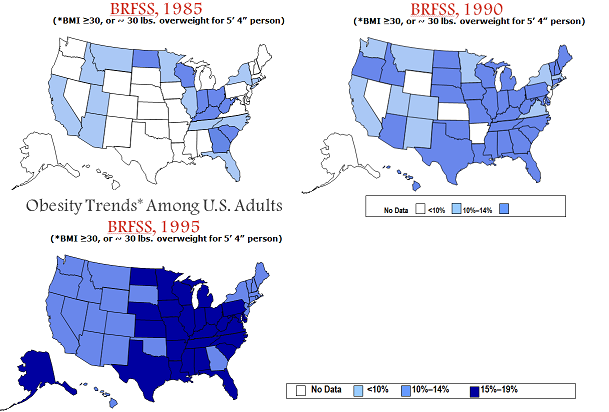
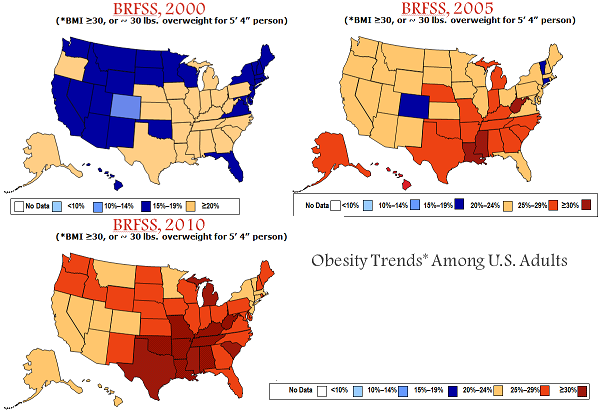
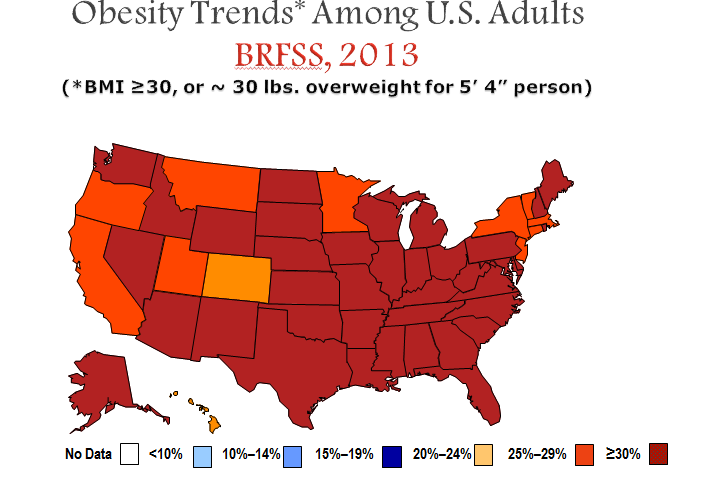 National Diabetes Data
National Diabetes Data
As you look at the maps, notice how the colors change across the country from light to dark. The darker the color, the higher the percentage of people with diagnosed diabetes. Keep in mind, this data only includes diagnosed diabetes. The actual number is higher because people with diabetes often do not know they have the disease until they experience symptoms.
According to the CDC, if the current trend continues one in three people born in 2000 will eventually develop diabetes.
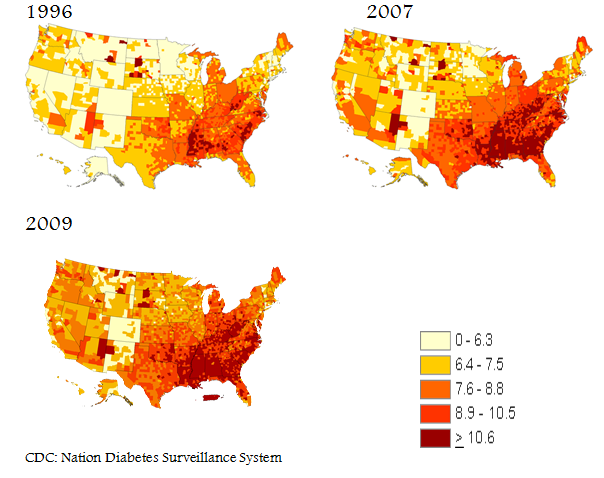
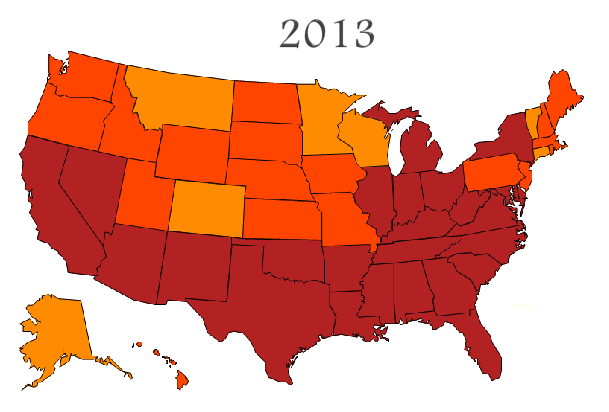
Lifestyle
- Poor eating habits
- Engaging in a little or no physical activity
- Having low HDL cholesterol, high triglycerides or high blood pressure
Race and ethnicity
- Type 2 diabetes is most common among certain racial and ethnic groups including: African Americans,
Hispanics, American Indians and Alaska Natives, Asian Americans, Native Hawaiians and other Pacific Islanders.
Age
- People older than 45 are at higher risk than are younger people.
Family History
- People with family members who have diabetes are at great risk than people without family members with
diabetes.
Gestational diabetes and large babies
- Women who had gestational diabetes or delivered a baby weighing 9 pounds or more are at higher risk.
Smoking
- Smokers have a 30% to 40% higher risk of Diabetes than nonsmokers.
Almost 29.1 million American have Diabetes. That is 1 in 11 people. The Center for Disease Control and
Prevention estimates that another 86 million more have prediabetes. That is one in three people.
Current estimates indicate that 90% of people with prediabetes do not know they have it.
If left untreated, 15-30% of people with prediabetes will develop type 2 diabetes within 5 years. That means up
to 25 million people will be diagnosed with diabetes.
There are three tests that can be done by a health care provider. They are:
Fasting plasma glucose (FPG): A person's blood glucose is measured after an 8-hour fast. Test
results indicate the following:
- Normal: 99 mg/dl or lower
- Prediabetes: from 100-125 mg/dl
- Diabetes: 126 mg/dl and higher
 Click here for the Pre-Diabetes Brochure
Oral glucose tolerance test (OGTT):
Click here for the Pre-Diabetes Brochure
Oral glucose tolerance test (OGTT): A person's blood glucose is measured after an 8-hour
fast and again 2 hours after drinking a glucose-rich solution. Results after drinking the glucose solution
indicate the following:
- Normal: 139 mg/dl or lower
- Prediabetes: 140-199 mg/dl
- Diabetes: 200 mg/dl or higher
Glycated Hemoglobin (HbA1c) test: Fasting is not necessary for this test. This measures a
person's average blood glucose over 8 to 12 weeks before the test is administered. Results indicate the
following:
- Normal: A1c lower than 5.7%
- Prediabetes: A1c 5.7% to 6.4%
- Diabetes: A1c 6.5% and higher
In addition to the tests completed by your health care provider, you may also complete the quiz Could You Have Prediabetes?
This quiz is found on the Center for Disease Control and Prevention's website found at
www.cdc.gov/diabetes.
The good news is that with healthy lifestyle changes (including weight loss and increased physical
activity), many people with prediabetes can restore their blood sugar to normal, thus reducing the risk of
developing type 2 diabetes. Enrolling in a Diabetes Prevention Program near you can help you achieve the weight
loss needed to reduce your risk of developing type 2 diabetes.
The Diabetes Prevention Program
The National Diabetes Prevention Program is based on the Diabetes Prevention Program research study led by the
National Institutes of Health and supported by the Centers for Disease Control and Prevention. This study showed
that making modest behavior changes, such as improving food choices and increasing physical activity to at least
150 minutes per week, helped participants lose 5% to 7% of their body weight. These lifestyle changes reduced
the risk of developing type 2 diabetes by 58% in people at high risk for diabetes.
The National Diabetes Prevention Program teaches participants strategies for eating healthy and incorporating
physical activity into daily life. Participants work with a lifestyle coach in a group setting.
Lifestyle coaches work with participants to identify emotions and situations that can sabotage their success,
and the group process encourages participants to share strategies for dealing with challenging situations.
Participants aim to lose 5% to 7% of their body weight by reducing fat and calories, and by being physically
active for 150 minutes a week (for a person weighing 200 pounds, the goal would be to lose 10 to 14 pounds.)
Participants get useful information about eating nutritious foods, eating the right portion sizes, reading food
labels, and adding physical activity.
The group interaction during the 16-week core program is crucial to the program's success. With a supportive
group to cheer their successes and empathize with their setbacks, participants don't have to make lifestyle
changes alone. The 6-month period of time after the core program is critical to maintaining healthy lifestyle
changes. Participants may have setbacks during this period but continue to work through these challenges with
the help of the lifestyle coach and other group members by sharing successful ways to help stay focused and
reinforcing positive strategies for maintaining healthy weight loss.
The following are two criteria that a person must meet in order to be eligible to enroll in a Diabetes
Prevention Program:
- Must be over 18 years of age AND Must have a Body Mass Index* (BMI) ≥ 24 or BMI ≥ 22 if Asian AND one of the below:
- FPGT Blood Test between 100-125 mg/dl or
- OGTT Blood Test between 140-199 mg/dl or
- A1C Blood Test between 5.7% - 6.4% or
- Gestational Diabetes Mellitus (GDM) or
- CDC Risk Test* score of 9 or higher
If you meet both 1 and any from 2 - 6, you are eligible to enroll in a Diabetes Prevention Program.
*To calculate BMI,
click here.
*To take the CDC Risk Test, click
here.